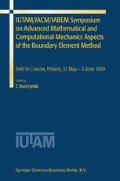Abstract
The boundary element method (BEM) for three-dimensional dynamic analysis of cracked structures is presented. The solutions are computed in time or frequency domain by using either the Laplace or the Fourier integral transform method. The displacement and the traction boundary integral equations are used in the present approach. The boundary geometry, displacements and tractions are approximated using either constant or quadratic elements. The dynamic stress intensity factors are computed using crack opening displacements. The method is used to analyze the dynamic behaviour of a rectangular bar with an internal square crack and a cracked thick-walled cylinder subjected to internal impact pressure.
Access this chapter
Tax calculation will be finalised at checkout
Purchases are for personal use only
Preview
Unable to display preview. Download preview PDF.
References
Aliabadi M.H. (1997) Boundary element formulations in fracture mechanics, Appl Mech. Rev., 50, 83–96.
Cruse T.A. and Rizzo, F.J. (1968) A direct formulation and numerical solution of the general transient elastodynamic problem. I, J. Math. Anal Appl., 22, 244–259.
Dominguez, J. (1993) Boundary Elements in Dynamics, Comp. Mech. Publ., Southampton.
Fedelinski, P. (1998a) The boundary element method in three- dimensional dynamic fracture mechanics — Part I: Theory, in Proc. XXXVII Symposium Modelling in Mechanics, Scient. Pap. Dep. Appl Mech., 6, 83–88.
Fedelinski, P. (1998b) The boundary element method in three- dimensional dynamic fracture mechanics — Part II: Examples, in Proc. XXXVII Symposium Modelling in Mechanics, Scient. Pap. Dep. Appl. Mech., 6, 89–94.
Fedelinski, P. (1998c) The three-dimensional boundary element method in dynamic analysis of cracks, Build. Res. J., 46, 257–275.
Gaul, L. and Fiedler, C. (1993) Improved calculation of field variables in the domain based on BEM, Engng. Anal Bound. Elem., 11, 257–264.
Guiggiani, M., Krishnasamy, G., Rudolphi, T.J. and Rizzo, F.J. (1992) A general algorithm for the numerical solution of hypersingu-lar boundary integral equations, Trans. ASME, J. Appl Mech., 59, 604–614.
Author information
Authors and Affiliations
Editor information
Editors and Affiliations
Rights and permissions
Copyright information
© 2001 Springer Science+Business Media Dordrecht
About this paper
Cite this paper
Fedelinski, P. (2001). Integral Transform Methods in 3-D Dynamic Fracture Mechanics. In: Burczynski, T. (eds) IUTAM/IACM/IABEM Symposium on Advanced Mathematical and Computational Mechanics Aspects of the Boundary Element Method. Springer, Dordrecht. https://doi.org/10.1007/978-94-015-9793-7_10
Download citation
DOI: https://doi.org/10.1007/978-94-015-9793-7_10
Publisher Name: Springer, Dordrecht
Print ISBN: 978-90-481-5737-2
Online ISBN: 978-94-015-9793-7
eBook Packages: Springer Book Archive

